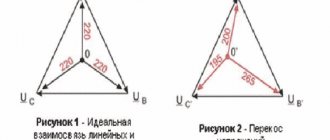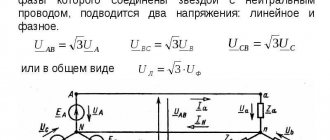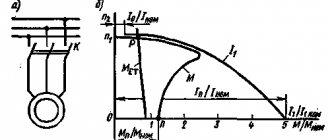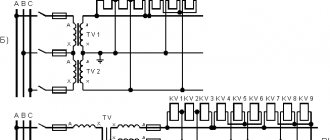Voltage parameters
Before you say that the voltage in your network does not meet the standard and file a claim with the energy supply organization, you need to know this standard. The voltage deviation range is set in normal mode: δUynorm= ± 5%, in the maximum permissible: δUylim= ± 10% of the nominal value.
In Russia, the rated voltage of the household network is Unom = 230 Volts (V), the upper range is 242 V. For Unom = 380 V, the upper range is 418 V. If the voltage is higher than these ranges and for this reason household appliances fail, you have the right to complain to the energy supply organization.
Overvoltage in apartment buildings
Recently, overvoltage in apartment buildings built before the early 90s has become a real disaster. When these houses were built, microwave ovens, refrigerators (two), computers, home solariums, etc. were not included in the design load.
But, nevertheless, consumers enjoy these benefits of civilization. What ends up happening? In the electric power industry there is a concept of evening and morning load peaks. It is at this time that people go to work, cook, turn on many electrical appliances in general.
burnout of the neutral conductor
If in normal mode the voltage between the phase and neutral conductors is 230 V, then in this case there is no neutral conductor and the voltage will be between the phases, i.e. 380 V. As a result, the voltage “walks” along the riser. Its value depends on the load connected to the network and can be in the range of 140 - 380 V from the point where the neutral conductor burns out.
Measures to normalize the voltage level in the network
Depending on the location of the impact, measures aimed at combating high voltage can be general, affecting the entire network, and local, applied to a specific consumer. Please note that for local measures, for example, at home or in an emergency, there is no need to coordinate the installation of the stabilizer with the electricity supplier. While general measures require contacting certain authorities.
Where to complain to solve the problem?
If the mains voltage is high, you can submit a corresponding request to the regulatory authorities to take action. This could be local city or village councils or the electricity supply organization directly. The first option is the most effective, since their function is to control the operation of the same RES. But due to the large number of transmission links, contacting local authorities is a lengthy procedure.
To contact the power supply organization, you need to not only report high voltage at your own connection, but also inquire about this parameter from neighboring consumers. Since if others are satisfied with the level, or one of them complains about low voltage, then they will definitely not lower it further.
As a rule, the Distribution Zone is in no hurry to respond to single requests that consider the interests of one consumer, but can affect the three-phase current for the entire group or area. Moreover, before this they could already make adjustments at the request of other persons. Therefore, in such cases, the fastest option to combat high potential differences is to install stabilizers and other protective devices.
How to reduce high voltage at home?
If you cannot influence the voltage level through a written request or it simply does not give the desired result, then it is necessary to install protection devices. Among the most common options are:
- Surge filter – allows you to eliminate short-term surge voltages. It is divided into several categories, depending on the complexity of the device and the specific operation of the protected object. Its disadvantage is the inability to eliminate long-term overvoltage in the network.
- Voltage regulator – allows you to change the value of high or low voltage at the input to the nominal value. This ensures not only ideal power supply to the consumer, but also its protection from emergency conditions - surges in electric current due to atmospheric overvoltages, short circuits, etc.
Figure 2: Normalization using stabilizer - Voltage control relay - disconnects all devices from the network in which low or high voltage has crossed the permissible deviation level. The natural drawback of the device is that it does not solve the problem of long-term increase in potential. And after switching the relay, you need to turn it back on yourself.
When installing automation that independently cuts off power in the event of overvoltage detection, uninterruptible power supplies can be used to restore power supply. Which will continue to power the equipment until the potential in the network normalizes.
Rice. 3. Example of turning on an uninterruptible power supply
Maximum voltage deviation in the electrical network
The current in the network is, for natural reasons, not constant and varies in certain parameters. Within the framework of the new 230 V/400 V standard, the nominal deviation is permissible within 5% and a maximum of no more than 10% should be observed in short-term intervals. Thus, such a theoretical deviation is allowed within 198 V and up to 242 V. This range can be considered relevant for most current apartments.
What affects network fluctuations in energy supply and voltage loss:
- One of the most common reasons is obsolescence of equipment, including meters, electrical panels, wiring cables, and so on;
- Significant errors are also observed in a poorly maintained network;
- Errors when planning and performing installation work in the house;
- Significant increase in energy consumption indicators exceeding the established standard.
As already noted, network fluctuations of +-5% are acceptable. So, for example, according to the supplied indicator of 220 volts, the permissible deviation in the network is equal to 209 V and the maximum excess is equal to 231 V.
Mandatory voltage regulation in electrical networks
Carrying out your own voltage regulation is not only labor-intensive, but also requires financial investment. An even more difficult option is to seek stabilization of the current in the network from the supplier organization. This can be done by filing complaints, personal appeals, and lawsuits, however, the result is not always achieved even by these methods.
If you still decide to correct the picture yourself, then this is possible in the following way:
- Method of centralized voltage regulation. This approach involves calculating how many changes will be needed to stabilize the situation and adjusting the central power supply accordingly.
- Linear impact method. This is done using a so-called linear regulator, which changes the phases using a secondary winding on the circuit.
- Use of capacitor banks in the network. This method is theoretically called reactive power compensation.
- Also, an extremely unstable network can be corrected using longitudinal compensation. It involves connecting capacitors in series to the network.
Another relevant option, if the deviation from the established norm is not too pronounced, is to install one large or several small stabilizers in the network. This will require some financial investments, special installation skills, and is also not suitable for highly fluctuating power supply systems, because they simply cannot do a large amount of work and regulate a large amount of voltage.
So, as has already been determined, the new generally accepted standard is the network voltage in an apartment from 230 V to 400 V. For example, the voltage scale can be 240 V, 250 V, taking into account the maximum permissible error. However, for the e1f outlet we are used to, the operating voltage is still the same 220V level, which has been familiar to us all since the Soviet period.
What is high voltage?
In any electrical network, be it household, industrial or high-voltage, there is a set level - 220V, 380V, 6 - 10 kV and others. These parameters must be within strictly established limits, not exceeding 5% of the norm for a long time and 10% for a short time. But in practice, there are situations when high voltage in the network may occur, exceeding the nominal value by 20%, 30% or more. Which creates a threat to electrical devices and humans in the event of a device breakdown and potential transfer to their housing. The reason for this increase may be various processes in the network.
Full voltage standards in the electrical network: GOST
Despite the fact that the majority of ordinary people and people who do not belong to the category of knowledgeable in the field of voltage in their electrical network will affirmatively say that the standard voltage is 220 V. To their surprise, even despite the old and familiar stickers, on which indicates the generally accepted standard are no longer relevant.
Such acts have also been adopted in Ukraine and the Baltic countries, including Belarus.
What did the change in standard lead to:
- The operating voltage on the power cable has changed;
- Fluctuations have become a little more significant than before, but still within the acceptable limits of 5% and the maximum – 10%;
- The potential payment for electricity supply services has not increased by a completely symbolic amount;
- Voltage supply frequency – 50 Hz.
Thus, the network voltage should be considered slightly increased in everyday practice. But in reality, everything is different, and this promises the presence of pitfalls in the supply of electricity to organizations. Despite the generally accepted standard, organizations supplying voltage to apartments in houses supply everything according to the same standards adopted back in Soviet times and equal to 220 V. All this happens officially in accordance with GOST 32144-2013, which is what suppliers are guided by.
Why is high voltage dangerous?
Despite the fact that many modern electrical appliances are equipped with switching power supplies, this still does not save them from high voltage. As a result, they may fail prematurely, and the warranty does not apply to such electrical appliances.
Heating elements, electric stoves and water heaters are most susceptible to increased voltage. Increased current flowing through the spiral of these electrical appliances seriously reduces their service life. High voltage is also unfavorable for the operation of various tools, as well as other equipment equipped with motors.
First of all, these are: air conditioners, refrigerators, fans, heat pumps, etc. Here, as a result of the increased current, the armature winding suffers. In addition, strong voltage surges lead to an increase in current consumption, so the wiring in the house is heavily loaded. All this can lead to serious problems and even cause a fire.
GOST 29322-92. Standard voltages
Of all the former republics of the USSR, Russia, Ukraine, and the Baltic countries switched to the “230V” standard.
It should be understood that electrical equipment manufactured in Russia and for Russia must operate normally at both 220V and 230V. As a rule, devices have a voltage range from -15% to +10% of the nominal voltage.
Geography of countries with standard voltages: 100V, 110V, 115V, 120V, 127V, 220V, 230V, 240V
Different countries around the world have adopted different mains voltage standards. You can find the following standards: - 100V in Japan, - 110V in Jamaica, Haiti, Honduras, Cuba, - 115V in Barbados, El Salvador, Trinidad, - 120V in the USA, Canada, Venezuela, Ecuador - 127V in Bonaire, Mexico, - 220V in many countries in Asia and Africa, - 230V in many countries of Europe and parts of Asia, - 240V in Afghanistan, Guyana, Gibraltar, Qatar, Kenya, Kuwait, Lebanon, Nigeria, Fiji
Geography of countries where voltages of 220V and 230V are accepted
The most widely used standards are 220V and 230V; these standards are accepted in more than 150 countries around the world.
In practice, of course, the network voltage is constantly changing and depends on many factors. Often the permissible voltage range is indicated on the back of the product or on the electrical plug of the device. The most demanding in terms of power quality are devices that have electric motors (refrigerators, air conditioners, washing machines, heating boilers, pumps). It is clear that for any devices used in Russia, both 220V and 230V voltages are good.
What are the deviations in power quality? It is well known that our networks often have significant deviations from power quality standards. And the voltage can be significantly lower than 220V or significantly higher than 230V. The reasons for this phenomenon are also known: aging of existing electrical networks, poor maintenance of networks, high wear and tear of network equipment, errors in network planning, and a large increase in electricity consumption. Problems in networks include: low and low voltage, high and high voltage, power surges. voltage dips, overvoltage, change in current frequency.
There is a solution to the problem! And every lover of country life has the right to provide himself with stable voltage using our equipment. We are waiting for your questions and comments by email. email [email protected]
5 reasons to buy a stabilizer from us
- urban comfort in your countryside, thanks to the stable operation of all electrical equipment
- consultation from our professional engineers to solve your specific problems
- warranty on our equipment is 3 (three!) years
- free delivery directly to you within the city
- installation of equipment by a professional electrical engineer
What is the network voltage
Since 2003, a standard voltage of 230V should have appeared in the sockets of our apartments and private houses. But for the past 17 years this transition has not been completed.
From September 30, 2014, instead of GOST 29322-92, GOST 29322-2014 (IEC 60038:2009) was adopted, establishing what the standard voltage should be in Russia. Now its value is 230 V (±10%) at a frequency of 50Hz (±0.2). But still quite often there is 220 V in the electrical network instead of the expected 230 V.
The rated parameters of AC power networks up to 1000 V are indicated in the table given in GOST 29322-2014.
In the first and second columns, the smaller values are the voltage between phase and neutral (phase), the larger values are between phases (linear). If one value is specified, it is the voltage between phases of a three-phase three-wire system.
The standard voltage of 230/400 V appeared as a result of the evolution of the 220/360 V and 240/415 V systems. Currently, the 220/360 system is no longer used in Europe and other countries, but 220/380 V and 240/415 V are still actively used.
The change in standards was caused by the need to bring electricity into full compliance with European parameters to facilitate the export and import of electricity and electrical devices.
Causes of power surges in the network
- The most common cause of voltage surges in the electrical network is transient processes that occur every time a consumer is connected or disconnected from the network. The more power the electrical installation is switched, the greater the amplitude of the voltage surge in the network. Examples: a neighbor connected a homemade “welder”. The mains voltage drops, especially when he starts welding. And if you simultaneously turn off all the electric heating devices in half of the apartment building, you will get an upward surge in the voltage in the electrical network.
- The next most common reason is a break or burnout of the neutral wire.
This defect occurs due to an emergency on power lines or due to poor quality of installation of power supply systems of residential buildings. With such a malfunction, the voltage may increase up to 380 volts due to the uneven distribution of loads on different phases in the electrical network. - Another reason for changes in the standard network voltage is installation errors during repairs. If a careless electrician connects the network phase to the neutral conductor, then instead of 220 volts in the sockets there will be 380.
- The only natural cause of overvoltage in the network is a lightning discharge. In this case, the magnitude of the difference depends on the proximity of the impact.
The danger of increased network voltage is obvious - electrical appliances fail and cannot withstand, from cheap incandescent lamps to expensive computers and televisions. What is the danger of low voltage?
IMPORTANT! The most vulnerable electrical installations to low voltage are those that contain motors. With a lack of electromotive force, the starting torque of the engine is significantly reduced (especially for asynchronous motors), they are not able to overcome the resistance of the connected mechanisms. The motor overheats and its windings burn out. The danger of such an outcome is most likely in compressor units (for example, refrigerators or air conditioners).
Voltage drop in the home network
The so-called voltage drop can be fraught with many undesirable consequences. Moreover, it is undesirable both by the residents themselves and by the supplier organization, because it will be the one who will cover all unforeseen expenses. For objective reasons described earlier, power outages can reach record levels.
If there is no desire to correct the defects, this is grounds for filing a claim in court.
What are the consequences of exceeding or significantly reducing the established norms for voltage supply in the house:
- Light bulbs burn out faster;
- This is especially harmful for a refrigerator, washing machine and other electrical household appliances that require powerful and constant voltage;
- The service life of any electrical equipment, including microwaves, toasters, TVs, computers, and so on.
Thus, it becomes obvious that all classes of electrical engineering suffer from severe voltage fluctuations. This influence is especially destructive if the network voltage is low. And the obligation to provide uninterrupted, stable and high-quality current belongs to the organization that supplies it and, according to the contract, must ensure its high-quality service.
How much do you need for electrical appliances?
Equipment manufactured in Russia for domestic consumers operates at both 220 V and 230 V, because manufacturers provide the required margin from -15% to +10%. from face value. But in each specific case, the permissible range of power supply characteristics for the device is indicated in the product passport or on its label. For example, computers can operate at 140 - 240 V, and a telephone charger at 110 - 250 V. These markings are often applied to the product itself.
Devices with electric motors are most sensitive to power quality. Here, a reduced voltage can lead to difficulties in starting and shortening the service life of the equipment, while an increased voltage will lead to overloads, which also shorten the service life. If you take a regular incandescent lamp and lower the supply voltage by 10%, the glow intensity will noticeably decrease, and if you increase it, its service life will be reduced by 4 times.
The permissible maximum network limit is 253 V. This value may be too high for electrical equipment designed for 220 volts. The difference in voltage will lead to overheating of power supplies, network adapters, and premature failure of devices.
If you notice that your equipment has begun to overheat or break down, check the voltage in the network. If a deviation of more than 10% is detected, immediately contact your network company. They are required to take measures to eliminate the factors that caused the violations.
Now you know what the voltage standard in the Russian network is according to GOST. If you have any questions, ask comments under the article. We hope the information was useful and interesting for you!
Is 220-240V voltage normal?
I installed ASP-1V, which, among other things, constantly displays the current voltage in the network. And this is what I noticed. Basically, the voltage is in the region of 230-234V. At the same time, in the evenings it drops to 221-224, at night it rises to 239-240V. Readings above 241V and below 220V were not noticed (it has been there for about 2 weeks).
The question is: are such “jumps” (if they can be considered such) normal?
Serg21220 wrote: Question - are such “jumps” (if they can be considered such) normal?
Within tolerance. For my equipment, excuse the tautology, voltage tolerance limits:
- Lighting 218 - 275 Volts AC with a frequency of 49 - 500 Hz, or 315 - 400 Volts DC, ideally 230 - 250 Volts AC, or 330 - 390 Volts DC.
- Appliances 200 - 240 Volts AC, ideally 230 Volts AC. Draw conclusions.
Plus or minus 5% is normal. Plus or minus 10% is the limit.
Previously, 10-15 years ago, voltage at 220V was not standardized. The network was rated at 380V and as far as I remember, it turned out to be 361-399V. I don’t know exactly how it is now.
Mowgli7111 wrote: ideally 230 - 250 Volts AC, or 330 - 390 Volts DC.
Explain, it's not clear what this is about.
knysh wrote: Previously, 10-15 years ago, voltage at 220V was not standardized.
Arr wrote: Quote: Message from Mowgli7111 ideally 230 - 250 Volts AC, or 330 - 390 Volts DC.
Explain, it's not clear what this is about.
About my Chinese fluorescent lamps with electronic ballasts. There is a sad experience of their failure due to low voltage. They never flew out from the increased voltage, unless you take into account minor damage to the ferrite magnetic core (sometimes it whistles very loudly, but works great) in one of the lamps, when an aunt from the energy supervision, while replacing the meter for a neighbor on the floor above, caused a short circuit in the riser (there was a short-term nightmare in sockets).
Amount of permissible voltage drop: PUE
According to the accepted rules for the design of electrical installations (PUE) back in the former USSR, a voltage drop is the difference in voltage levels at different points of the network. As a rule, these are the starting and ending points of the chain. In established standards, the law requires a distinction between the concepts of voltage deviation and voltage loss. If the first case, on a generally accepted scale, is considered using the example of an incandescent lamp, the deviation indicator of which is recognized as nominal and mandatory, then in the case of the loss considered on the station buses, this is recognized as a recommended indicator.
Normal voltage drop in the network:
- In so-called overhead lines – up to 8%;
- In cable power supply lines – up to 6%;
- In networks of 220 V - 380 V - in the region of 4-6%.
In this case, a drop in the emergency mode is considered to be a drop of up to 12% in the network - this is the established limit. A fall above the established norm promises the activation of the automatic protective system, which should be activated when the lower norm is reached for at least 30 seconds.
Also in some sources you can find voltage standards that exceed even the new indicators of 230 V and 400 V. Do not confuse examples of domestic use with a plant or factory, where the indicators naturally significantly exceed the domestic environment.
Typical frequently asked questions from readers
I connected the LIEBHERR {CUN3033} refrigerator via a PH-122 voltage relay. For about a week everything was fine, the network voltage was within the upper limit, the factory setting was 250 volts, and the refrigerator was working. But from December 31 to this day, the relay shows 250-253 volts and the refrigerator is turned off for approximately 5 hours a day. And at night I don’t even know how it works. Please tell me, is it possible to set the upper limit on the relay to 255 volts or is this unacceptable for a refrigerator? Could the relay be faulty? And why is there such high voltage in the network in an apartment in Moscow, or is this the norm? Please advise what to do? And also, the relay gets warm, a little, but the body is warm, is this normal or not?
As I understand it, you installed the RN-122 voltage control relay in the plug socket for connecting the refrigerator. There are many questions, but let's consider everything in order. If we consider the permissible response limits, then, in accordance with the passport data, the regulation range for Umax is from 230 to 290 V. Therefore, yes, you can set the maximum voltage limit to more than 250 V.
The fact that you have set the maximum limit Umax to 250 V indicates that you are using the factory settings (for the RN-122 voltage control relay, the minimum voltage response threshold is 185 V, and the maximum voltage is 250 V). To change the value of the maximum response threshold, you need to perform the following steps (see the figure on the link):
Regarding the rated voltage, in accordance with GOST 32144-2013, the maximum limit is 253 V (that is, +10% to 230 V). But for many household appliances this is too much. I recommend that you double-check it with a multimeter or voltmeter; if this is indeed the case, contact the management company with an official statement. Otherwise, the relay may actually be faulty and simply needs to be replaced.











